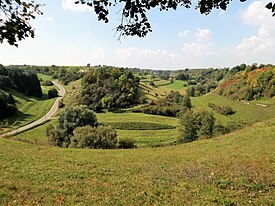Repentance
|
Repentance
Ammerbuch municipality
|
|
|---|---|
| Coordinates: 48 ° 32 ′ 32 ″ N , 8 ° 55 ′ 13 ″ E | |
| Height : | 373 (370-442) m |
| Area : | 6.11 km² |
| Residents : | 973 (March 1, 2015) |
| Population density : | 159 inhabitants / km² |
| Incorporation : | 1st December 1971 |
| Postal code : | 72119 |
| Area code : | 07073 |
|
Location of Reusten in Ammerbuch
|
|
Reusten is a district of Ammerbuch , a municipality in the Baden-Württemberg district of Tübingen in Germany . The village is about 12 km west of Tübingen and about 8 km east of Herrenberg .
geography
The settlement lies between Poltringen and Altingen at the confluence of the Ammer and Kochhart rivers . The Kirchberg and the Ammertal slopes rise prominently in the center of Reusten as geological formations above Kochhartgraben and Ammertal. Today, Kochhart is mainly fed by the sewage treatment plant in Hailfingen . It rises northwest of Bondorf. The Ammer rises from five spring pots southeast of Herrenberg.
Reusten is the second smallest district of Ammerbuch and has 973 inhabitants.
history
Reusten was founded by the Alemanni around the 6th century . The name can probably be derived from the Alemannic first name Rusto . During excavations, Neolithic settlements were discovered on the Kirchberg. The oldest finds can be dated to around 4500 BC. Backdate. Remains of the medieval Kräheneck castle still puzzles about its inhabitants. The Church of the Holy Cross was built on the Kirchberg by monks from the Bebenhausen Monastery around 1300 and stood up there until 1759. An old Roman road that once ran north of the Wolfsberg settlement and which was later called "Königsstraße" must be mentioned. In the Middle Ages, there was an old Germanic court on it. A donation at the time of Emperor Lothar, which was sealed on this court, was the reason for the first documentary mention of "Rusten" in the donation book of the Reichenbach monastery; written between 1138 and 1152.
The people of Reusten received the nickname "Totenrugeler" (Swabian Daudarugaler) according to an anecdote: at a winter funeral on the Kirchberg - the cemetery is located there - one of the pallbearers is said to have slipped and the coffin and the dead person to have "rolled" down the mountain.
The founder of the Swabian dialect theater, Gottlieb Friedrich Wagner, was born in Reusten on November 3, 1774 . From 1946 to 1951, the athlete for heavy athletics, Fritz Wenninger, lived here in the Gasthof Lamm .
On December 1, 1971, Reusten merged with five other municipalities to form the new municipality of Ammerbuch.
|
coat of arms
The municipal coat of arms, adopted in 1954, shows a red oblique left bar in gold, above a royal crown, which is accompanied by a green linden branch below . The beam and the crown are intended to remind of the Königsstrasse, which once ran through the district. The linden branch indicates the place of justice ( court linden tree ). The colors red and gold are taken from the coat of arms of the Tübingen Count Palatine. The coat of arms was valid until Ammerbuch was founded in 1971, now the Ammerbuch coat of arms is valid.
Infrastructure
In Reusten there is a town hall, a cemetery, a kindergarten and a youth club. There is also a butcher's shop and a small village shop, as well as the Gasthaus zum Löwen in the town center.
The elementary and special school was closed because the number of students was too low. Primary school students now attend the primary school in Poltringen, while the Rottenburg special school is responsible for special needs students. The school is currently occupied by the Ammerbuch Community School.
There is a bus connection to Altingen or Pfäffingen , where you can take the train ( Ammertalbahn ) to Tübingen (with an occasional connection via Reutlingen , Metzingen and Nürtingen to Wendlingen am Neckar ) and Herrenberg (there connection to the Stuttgart S-Bahn ).
Tithe shy
A support association is dedicated to the task of converting the tithe barn, built in 1575, next to the wine press church, into a culture barn with a community center.
Sports
In Reusten there is a gymnastics and singing club, the TGV Reusten. This has a syndicate with TV Nebringen, SG Nebringen / Reusten. There is also a riding club. In addition, an annual handball tournament takes place on the sports field in Reusten.
religion
The Protestant church of Reusten is located in the center of the village. In 1760 the former Bebenhauser wine press was converted into a church.
Individual evidence
- ^ Federal Statistical Office (ed.): Historical municipality directory for the Federal Republic of Germany. Name, border and key number changes in municipalities, counties and administrative districts from May 27, 1970 to December 31, 1982 . W. Kohlhammer, Stuttgart / Mainz 1983, ISBN 3-17-003263-1 , p. 535 .
literature
- Reusten and his story by Roland Fakler, DIN A5 136 pages, 80 images, 26 colored pages, Verlag Books on Demand GmbH, Norderstedt, ISBN 978-3-8370-4383-9
Web links
- Wikisource: Reusten in the description of the Oberamt Herrenberg from 1855





